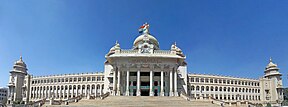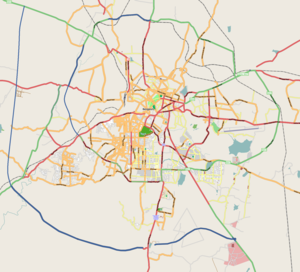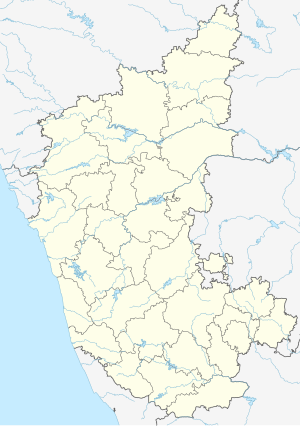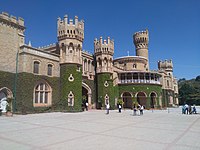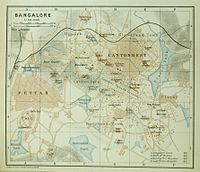
A | B | C | D | E | F | G | H | CH | I | J | K | L | M | N | O | P | Q | R | S | T | U | V | W | X | Y | Z | 0 | 1 | 2 | 3 | 4 | 5 | 6 | 7 | 8 | 9
Bangalore
Beṁgaḷūru | |
|---|---|
| Bengaluru | |
| Nicknames: | |
 | |
| Coordinates: 12°58′44″N 77°35′30″E / 12.97889°N 77.59167°E | |
| Country | |
| State | |
| Region | Bayaluseemé |
| Districts | Bangalore Urban |
| Established | 1537 |
| Founded by | Kempe Gowda I |
| Government | |
| • Type | Municipal Corporation |
| • Mayor | Vacant |
| • Corporation Commissioner | Tushar Giri Nath, IAS[1] |
| Area | |
| • Metropolis | 741 km2 (286 sq mi) |
| • Metro | 8,005 km2 (3,091 sq mi) |
| Elevation | 920 m (3,020 ft) |
| Population (2011)[5] | |
| • Metropolis | 8,443,675 |
| • Rank | 3rd |
| • Density | 11,000/km2 (30,000/sq mi) |
| • Urban | 10,456,000 |
| • Rank | 5th |
| Demonym(s) | Bangalorean, Bengalurinavaru, Bengalurean, Bengaluriga, Bangalori |
| Time zone | UTC+05:30 (IST) |
| Pincode(s) | 560 xxx |
| Area code | +91-(0)80 |
| Vehicle registration | KA:01-05, 41, 50-53, 57-61 |
| GDP (PPP) | $300 billion[8][9] |
| Official language | Kannada[10] |
| Website | www |
Bangalore (/ˈbæŋɡəlɔːr, ˌbæŋɡəˈlɔːr/ BANG-gə-lor, -LOR), officially Bengaluru (Kannada pronunciation: [ˈbeŋgɐɭuːɾu] ; ISO: Beṁgaḷūru), is the capital and largest city of the southern Indian state of Karnataka. It has a population of more than 8 million and a metropolitan population of around 15 million, making it India's third most populous city and fourth most populous urban agglomeration. It is the most populous city and largest urban agglomeration in South India, and is the 27th largest city in the world.[11] Located on the Deccan Plateau, at a height of over 900 m (3,000 ft) above sea level, Bangalore has a pleasant climate throughout the year, with its parks and green spaces earning it the reputation of India's "Garden City".[12] Its elevation is the highest of India's major cities.[13]
The city's history dates back to around 890, as per the old Kannada stone inscription found at the Nageshwara Temple in Begur, Bangalore. In 1537, Kempé Gowdā, a feudal ruler under the Vijayanagara Empire, established a mud fort, considered the foundation of modern Bangalore and its oldest areas, or pétés, which still exist. After the fall of the Vijayanagara Empire, Kempe Gowda declared independence; in 1638, a large Adil Shahi Bijapur army defeated Kempe Gowda III, and Bangalore came under Shahaji Bhonsle as a jagir, which later became his capital. The Mughals later captured Bangalore and sold it to Maharaja Devaraja Wodeyar II of the Kingdom of Mysore.[14] When Haider Ali seized control of the kingdom, Bangalore's administration passed into his hands.
The city was captured by the British East India Company after victory in the Fourth Anglo-Mysore War (1799), which then returned administrative control of the city, along with the kingdom, to Maharaja Krishnaraja Wadiyar III. The old city developed under the dominions of the maharaja. In 1809, the British shifted their cantonment to Bangalore, outside the old city, and a town grew up around it. Following India's independence in 1947, Bangalore became the capital of Mysore State, and remained the capital when the state was enlarged and unified in 1956 and renamed Karnataka in 1973. The two urban settlements of Bangalore, the town and the cantonment, which had developed as independent entities, merged into a single urban centre in 1949. The existing Kannada name, Bengalūru, was declared the city's official name in 2006.
Bangalore is considered to be one of the fastest-growing global major metropolises.[15][16] Recent estimates of the metro economy of its urban area has ranked Bangalore as one of the most productive metro areas of India.[17][18] The city is considered the pivot for high-technology-based heavy manufacturing industry, with numerous large multinational technology corporations setting up their headquarters there. It is home to many top-tier engineering and research institutions. Bangalore is known as the "Silicon Valley of India" because it is the nation's leading software exporter as well as a major semiconductor hub.[19] Several state-owned aerospace and defence organisations are in the city. The presence of numerous notable sporting arenas in Bangalore makes it one of the country's sporting hubs.
Etymology
Bangalore is an anglicised version of the city's Kannada name Bengalūru. It was the name of a village near Kodigehalli in Bangalore city today and was used by Kempe Gowda to name the city as Bangalore at the time of its foundation in 1537. The earliest reference to the name "Bengalūru" was found in a ninth-century Western Ganga dynasty stone inscription on a vīra gallu (Kannada: ವೀರಗಲ್ಲು; lit. 'hero stone', a rock edict extolling the virtues of a warrior). According to an Old Kannada inscription found in Begur, "Bengalūrū" was the place of a battle in 890 CE.[20][21]
It was also referred to as "Kalyānapura" or "Kalyānapuri" ("Auspicious City") and "Dēvarāyanagara" during the Vijayanagara times.[22]
An apocryphal story states that the twelfth-century Hoysala king Veera Ballala II, while on a hunting expedition, lost his way in the forest. Tired and hungry, he came across a poor old woman who served him boiled beans. The grateful king named the place "Benda-Kaal-uru" (literally, "town of boiled beans"), which eventually evolved into "Bengalūru".[20][23][24] Suryanath Kamath has put forward an explanation of a possible floral origin of the name as derived from benga, the Kannada term for Pterocarpus marsupium (also known as the Indian Kino Tree), a species of dry and moist deciduous trees that grows abundantly in the region.[25]
On 11 December 2005, the Government of Karnataka accepted a proposal by Jnanpith Award winner U. R. Ananthamurthy to rename Bangalore to Bengalūru.[26] On 27 September 2006, the Bruhat Bengaluru Mahanagara Palike (BBMP) passed a resolution to implement the name change.[27] The government of Karnataka accepted the proposal and it was decided to officially implement the name change from 1 November 2006.[28][29] The Union government approved this request, along with name changes for 11 other Karnataka cities, in October 2014. Hence, Bangalore was renamed to "Bengaluru" on 1 November 2014.[30][31]
History
Early and medieval history
A discovery of Stone Age artefacts during the 2001 Census of India at Jalahalli, Sidhapura and Jadigenahalli, all of which are located on Bangalore's outskirts today, suggest human settlement around 4000 BCE.[32] Around 1,000 BCE (during the Iron Age), burial grounds were established at Koramangala and Chikkajala on the outskirts of Bangalore. Coins of the Roman emperors Augustus, Tiberius, and Claudius found at Yeswanthpur and HAL Airport indicate that the region was involved in trans-oceanic trade with the Romans and other civilisations in 27 BCE.[33]
The region of modern-day Bangalore was part of several successive South Indian kingdoms. Between the fourth and tenth centuries, the region was ruled by the Western Ganga dynasty of Karnataka, the first dynasty to set up effective control over the region.[34] According to Edgar Thurston, there were twenty-eight kings who ruled Gangavadi from the start of the Christian era until its conquest by the Cholas. The Western Gangas ruled the region initially as a sovereign power (350–550 CE), and later as feudatories of the Chalukyas of Badami, followed by the Rashtrakutas until the tenth century.[25] The Begur Nageshwara Temple was commissioned around 860, during the reign of the Western Ganga King Ereganga Nitimarga I, and extended by his successor Nitimarga II.[35][36] Around 1004, during the reign of Raja Raja Chola I, the Cholas defeated the Western Gangas under the command of the crown prince Rajendra Chola I, and captured Bangalore.[35][37] During this period, the Bangalore region witnessed the migration of many groups—warriors, administrators, traders, artisans, pastorals, cultivators, and religious personnel from Tamil Nadu and other Kannada-speaking regions.[34] The Chokkanathaswamy temple at Domlur, the Aigandapura complex near Hesaraghatta, Mukthi Natheshwara Temple at Binnamangala, Choleshwara Temple at Begur, Someshwara Temple at Ulsoor, date from the Chola era.[35]
In 1117, the Hoysala king Vishnuvardhana defeated the Cholas in the Battle of Talakad in south Karnataka, and extended its rule over the region.[35] Vishnuvardhana expelled the Cholas from all parts of the Mysore state.[38] By the end of the 13th century, Bangalore became a source of contention between two warring cousins, the Hoysala ruler Veera Ballala III of Halebidu and Ramanatha, who administered from the Hoysala held territory in Tamil Nadu.[35] Veera Ballala III had appointed a civic head at Hudi (now within Bangalore Municipal Corporation limits), thus promoting the village to the status of a town. After Veera Ballala III's death in 1343, the next empire to rule the region was the Vijayanagara Empire, which itself saw the rise of four dynasties, the Sangamas (1336–1485), the Saluvas (1485–1491), the Tuluvas (1491–1565), and the Aravidu (1565–1646).[39] During the reign of the Vijayanagara Empire, Achyuta Deva Raya of the Tuluva dynasty raised the Shivasamudra Dam across the Arkavati river at Hesaraghatta, whose reservoir is the present city's supply of regular piped water.[40]
Foundation and early modern history
Modern Bangalore was begun in 1537 by the chieftain Kempe Gowda I, who aligned with the Vijayanagara Empire under Emperor Achyuta Deva Raya to campaign against Gangaraja (whom he defeated and expelled to Kanchi), and who built a mud-brick fort for the people at the site that would become the central part of modern Bangalore. Kempe Gowda was restricted by rules made by the Emperor, who feared the potential power of Kempe Gowda and did not allow a stone fort. Kempe Gowda referred to the new town as his "gandubhūmi" or "Land of Heroes".[24] Within the fort, the town was divided into smaller divisions, each called a pētē (Kannada pronunciation: [peːteː]).[42] The town had two main streets—Chikkapētē Street and Doddapētē Street.[43] Their intersection formed the Doddapētē Square—the heart of Bangalore. Kempe Gowda I's During the Vijayanagara rule, many saints and poets referred to Bangalore as "Devarāyanagara" and "Kalyānapura" or "Kalyānapuri" ("Auspicious City").[44]
After the fall of the Vijayanagara Empire in 1565 in the Battle of Talikota, Kempe Gowda I declared independence. His successor, Kempe Gowda II, built four towers that marked Bangalore's boundary.[45] Then in 1638, a large Adil Shahi Bijapur army led by Ranadulla Khan and accompanied by his second in command Shāhji Bhōnslē defeated Kempe Gowda III, and Bangalore was given to Shāhji as a jagir (feudal estate). Around 1639, he ordered the reconstruction of the destroyed city and the building of new lakes to solve the water shortage in the region.[44] In 1687, the Mughal general Kasim Khan, under orders from Aurangzeb, defeated Ekoji I, son of Shāhji, and sold Bangalore to Chikkadevaraja Wodeyar (1673–1704), the then ruler of the Kingdom of Mysore for three lakh rupees.[14] After the death of Krishnaraja Wodeyar II in 1759, Hyder Ali, Commander-in-Chief of the Mysore Army, proclaimed himself the de facto ruler of the Kingdom of Mysore. Hyder Ali is credited with building the Delhi and Mysore gates at the northern and southern ends of the city in 1760.[46] The kingdom later passed to Hyder Ali's son Tipu Sultan. Hyder and Tipu directed the building of the Lal Bagh Botanical Gardens in 1760.[47] Under them, Bangalore developed into a commercial and military centre of strategic importance.[44]
The Bangalore fort was captured by British forces under Lord Cornwallis on 21 March 1791 during the Third Anglo-Mysore War and formed a centre for British resistance against Tipu Sultan.[48] Following Tipu's death in the Fourth Anglo-Mysore War (1799), the British returned administrative control of the Bangalore pētē to the Maharaja of Mysore and was incorporated into the Princely State of Mysore, which existed as a nominally sovereign entity of the British Raj. The old pētē developed in the dominions of the Maharaja of Mysore. The Residency of Mysore State was first established in Mysore City in 1799 and later shifted to Bangalore in 1804.[49] It was abolished in 1843,[49] only to be revived in 1881 at Bangalore and closed down permanently in 1947, with Indian independence.[50] The British found Bangalore to be a pleasant and appropriate place to station their garrison and therefore moved their cantonment to Bangalore from Seringapatam in 1809 near Ulsoor, about 6 km (4 mi) northeast of the city. A town grew up around the cantonment, by absorbing several villages in the area. The new centre had its own municipal and administrative apparatus, though technically it was a British enclave within the territory of the Wodeyar Kings of the Princely State of Mysore.[51] Two important developments which contributed to the rapid growth of the city, include the introduction of telegraph connections to all major Indian cities in 1853 and a rail connection to Madras (now Chennai), in 1864.[52]
Later modern and contemporary history
In the 19th century, Bangalore essentially became a twin city, with the "pētē", whose residents were predominantly Kannadigas and the cantonment created by the British.[53] Throughout the 19th century, the Cantonment gradually expanded and acquired a distinct cultural and political salience as it was governed directly by the British and was known as the Civil and Military Station of Bangalore. While it remained in the princely territory of Mysore, Cantonment had a large military presence and a cosmopolitan civilian population that came from outside the princely state of Mysore, including British and Anglo-Indians army officers.[54]
Bangalore was hit by a plague epidemic in 1898 that claimed nearly 3,500 lives. The crisis caused by the outbreak catalysed the city's sanitation process. Telephone lines were laid to help co-ordinate anti-plague operations. Regulations for building new houses with proper sanitation facilities came into effect. A health officer was appointed and the city divided into four wards for better co-ordination. Victoria Hospital was inaugurated in 1900 by Lord Curzon, the then Governor-General of British India.[55] New extensions in Malleswaram and Basavanagudi were developed in the north and south of the pētē.[56] In 1903, motor vehicles came to be introduced in Bangalore.[57] In 1906, Bangalore became one of the first cities in India to have electricity from hydro power, powered by the hydroelectric plant situated in Shivanasamudra.[58] The Indian Institute of Science was established in 1909, which subsequently played a major role in developing the city as a science research hub.[59] In 1912, the Bangalore torpedo, an offensive explosive weapon widely used in World War I and World War II, was devised in Bangalore by British army officer Captain McClintock of the Madras Sappers and Miners.[60]
Bangalore's reputation as the "Garden City of India" began in 1927 with the silver jubilee celebrations of the rule of Krishnaraja Wodeyar IV. Several projects such as the construction of parks, public buildings and hospitals were instituted to improve the city.[61] Bangalore played an important role during the Indian independence movement. Mahatma Gandhi visited the city in 1927 and 1934 and addressed public meetings here.[33] In 1926, the labour unrest in Binny Mills due to demand by textile workers for payment of bonus resulted in lathi charging and police firing, resulting in the death of four workers, and several injuries.[62] In July 1928, there were notable communal disturbances in Bangalore, like when a Ganesh idol was removed from a school compound in the Sultanpet area of Bangalore.[63] In 1940, the first flight between Bangalore and Bombay took off, which placed the city on India's urban map.[59]
After India's independence in August 1947, Bangalore remained in the newly carved Mysore State of which the Maharaja of Mysore was the Rajapramukh (appointed governor).[64] The "City Improvement Trust" was formed in 1945, and in 1949, the "City" and the "Cantonment" merged to form the Bangalore City Corporation.[65] The Government of Karnataka later constituted the Bangalore Development Authority in 1976 to coordinate the activities of these two bodies.[66] Public sector employment and education provided opportunities for Kannadigas from the rest of the state to migrate to the city. Bangalore experienced rapid growth in the decades 1941–51 and 1971–81, which saw the arrival of many immigrants from northern Karnataka. The Government of India set up the All India Institute of Mental Health (AIIMH) in 1956. By 1961, Bangalore had become the sixth-largest city in India, with a population of 1,207,000.[44] In the following decades, Bangalore's manufacturing base continued to expand with the establishment of private companies such as MICO (Motor Industries Company), which set up its manufacturing plant in the city.[67][68]
By the 1980s, urbanisation had spilled over the current boundaries, and in 1986, the Bangalore Metropolitan Region Development Authority, was established to co-ordinate the development of the entire region as a single unit.[66] On 8 February 1981, a major fire broke out at Venus Circus in Bangalore, where more than 92 people died, the majority of them children.[69] Bangalore experienced a growth in its real estate market in the 1980s and 1990s, spurred by capital investors from other parts of the country who converted Bangalore's large plots and colonial bungalows into multi-storied apartments.[70] In 1985, Texas Instruments became the first multinational corporation to set up base in Bangalore. Other information technology companies followed suit and by the end of the 20th century, Bangalore had established itself as the Silicon Valley of India.[44] Today, Bangalore is India's third most populous city.[71] During the 21st century, Bangalore has had major terrorist attacks in 2008, 2010, and 2013.[72][73][74]
Geography

Bangalore lies in the southeast of the South Indian state of Karnataka. It is in the heart of the Mysore Plateau (a region of the larger Cretaceous Deccan Plateau) at an average elevation of 900 m (2,953 ft).[75]: 8 It covers an area of 741 km2 (286 sq mi).[76] The majority of the city of Bangalore lies in the Bangalore Urban district of Karnataka and the surrounding rural areas are a part of the Bangalore Rural district. The Government of Karnataka has carved out the new district of Ramanagara from the old Bangalore Rural district.[77]
Bangalore's topography is generally flat, although the western parts of the city are hilly. The highest point is Vidyaranyapura Doddabettahalli, 962 m (3,156 ft) above sea level, situated to the northwest of the city.[78] No major rivers run through the city, although the Arkavathi and South Pennar cross paths at the Nandi Hills, 60 km (37 mi) to the north. River Vrishabhavathi, a minor tributary of the Arkavathi, arises within the city at Basavanagudi and flows through the city. The rivers Arkavathi and Vrishabhavathi together carry much of Bangalore's sewage.[79][80] A sewerage system, constructed in 1922, covers 215 km2 (83 sq mi) of the city and connects with five sewage treatment centres located in the city's periphery.[81]
In the 16th century, Kempe Gowda I constructed many lakes to meet the town's water requirements. The Kempambudhi Kere, since overrun by modern development, was prominent among those lakes. In the first half of the 20th century, the Nandi Hills waterworks were commissioned by Sir Mirza Ismail (Diwan of Mysore, 1926–41 CE) to provide a water supply to the city. Kaveri River flows about 60 miles (100 km) from the city of Bengaluru,[82] and the river Kaveri provides around 80% of the city's water supply and the remaining 20% is obtained from the Thippagondanahalli and Hesaraghatta reservoirs of the Arkavathi river.[83] Bangalore receives 800 million litres (210 million US gallons) of water a day, more than any other Indian city,[84] but Bangalore does face occasional water shortages, especially during summer and in years with low rainfall.[85] A random sampling of the air quality index (AQI) of twenty stations within the city ranged from 76 to 314, suggesting heavy to severe air pollution around areas of high traffic.[86]
Bangalore has a handful of freshwater lakes and water tanks, the largest of which are Madivala tank, Hebbal Lake, Ulsoor Lake, Yediyur Lake and Sankey Tank. However, about 90% of Bangalore's lakes are polluted;[87][88][89] the city government began revival and conservation efforts in December 2020.[90] Groundwater occurs in silty to sandy layers of the alluvial sediments. The Peninsular Gneissic Complex (PGC) is the most dominant rock unit in the area and includes granites, gneisses and migmatites, while the soils of Bangalore consist of red laterite and red, fine loamy to clayey soils.[86]
The city's vegetation is mostly large deciduous canopy and some coconut trees.[91] Many trees are frequently felled to pave way for infrastructure development.[92][93] Though Bangalore has been classified as a part of the seismic zone II (a stable zone), it has experienced earthquakes of magnitude as high as 4.5 on the Richter scale.[94]
Climate
Bangalore has a tropical savanna climate (Köppen climate classification Aw) with distinct wet and dry seasons. Due to its high elevation, Bangalore usually enjoys a more moderate climate throughout the year, although occasional heat waves can make summer somewhat uncomfortable.[95] The coolest month is January with an average low temperature of 15.1 °C (59.2 °F) and the hottest month is April with an average high of 34.1 °C (93.4 °F).[96] The highest temperature ever recorded in Bangalore is 39.2 °C (103 °F), recorded 24 April 2016, corresponding with the strong El Niño in that year.[97] The lowest ever recorded is 7.8 °C (46 °F) in January 1884.[98][99] Winter temperatures rarely drop below 14 °C (57 °F), and summer temperatures seldom exceed 36 °C (97 °F). Bangalore receives rainfall from both the northeast and the southwest monsoons, and the wettest months is September, followed by October and August.[96] The summer heat is moderated by fairly frequent thunderstorms, which occasionally cause power outages and local flooding. Most of the rainfall occurs during the late afternoon or evening and rain before noon is infrequent. November 2015 (290.4 mm) was recorded as one of the wettest months in Bangalore with heavy rains causing severe flooding in some areas, and closure of a number of organisations for over a couple of days.[100] The heaviest rainfall recorded in a 24-hour period is 179 mm (7 in) recorded on 1 October 1997.[101] In 2022, Bangalore faced a large amount of rainfall, which was 368% more than the yearly average.[102] Several areas were flooded, and power supply was also cut off.[103][104]
| Climate data for Bangalore (1991–2020, extremes 1901–present) | |||||||||||||
|---|---|---|---|---|---|---|---|---|---|---|---|---|---|
| Month | Jan | Feb | Mar | Apr | May | Jun | Jul | Aug | Sep | Oct | Nov | Dec | Year |
| Record high °C (°F) | 32.8 (91.0) |
35.9 (96.6) |
37.9 (100.2) |
39.2 (102.6) |
38.9 (102.0) |
38.1 (100.6) |
33.3 (91.9) |
33.3 (91.9) |
33.3 (91.9) |
32.4 (90.3) |
33.0 (91.4) |
31.1 (88.0) |
39.2 (102.6) |
| Mean daily maximum °C (°F) | 28.4 (83.1) |
30.9 (87.6) |
33.4 (92.1) |
34.1 (93.4) |
33.1 (91.6) |
29.7 (85.5) |
28.3 (82.9) |
28.1 (82.6) |
28.6 (83.5) |
28.5 (83.3) |
27.4 (81.3) |
26.9 (80.4) |
29.8 (85.6) |
| Daily mean °C (°F) | 22.3 (72.1) |
24.3 (75.7) |
26.8 (80.2) |
28.1 (82.6) |
27.4 (81.3) |
25.2 (77.4) |
24.2 (75.6) |
24.1 (75.4) |
24.3 (75.7) |
24.0 (75.2) |
22.9 (73.2) |
21.7 (71.1) |
24.6 (76.3) |
| Mean daily minimum °C (°F) | 16.1 (61.0) |
17.6 (63.7) |
20.2 (68.4) |
22.1 (71.8) |
21.8 (71.2) |
20.6 (69.1) |
20.1 (68.2) |
20.0 (68.0) |
20.0 (68.0) |
19.8 (67.6) |
18.3 (64.9) |
16.4 (61.5) |
19.4 (66.9) |
| Record low °C (°F) | 7.8 (46.0) |
9.4 (48.9) |
11.1 (52.0) |
14.4 (57.9) |
16.7 (62.1) |
16.7 (62.1) |
16.1 (61.0) |
14.4 (57.9) |
15.0 (59.0) |
13.2 (55.8) |
9.6 (49.3) |
8.9 (48.0) |
7.8 (46.0) |
| Average rainfall mm (inches) | 1.6 (0.06) |
7.1 (0.28) |
14.7 (0.58) |
61.7 (2.43) |
128.7 (5.07) |
110.3 (4.34) |
116.4 (4.58) |
162.7 (6.41) |
208.3 (8.20) |
186.4 (7.34) |
64.5 (2.54) |
15.4 (0.61) |
1,077.8 (42.43) |
| Average rainy days | 0.2 | 0.3 | 1.1 | 4.0 | 7.5 | 6.8 | 8.0 | 10.2 | 9.5 | 9.6 | 4.2 | 1.3 | 62.7 |
| Average relative humidity (%) (at 17:30 IST) | 41 | 32 | 29 | 35 | 47 | 62 | 65 | 67 | 64 | 65 | 61 | 53 | 52 |
| Average dew point °C (°F) | 13 (55) |
12 (54) |
13 (55) |
17 (63) |
19 (66) |
19 (66) |
19 (66) |
19 (66) |
19 (66) |
18 (64) |
17 (63) |
15 (59) |
17 (62) |
| Mean monthly sunshine hours | 262.3 | 247.6 | 271.4 | 257.0 | 241.1 | 136.8 | 111.8 | 114.3 | 143.6 | 173.1 | 190.2 | 211.7 | 2,360.9 |
| Average ultraviolet index | 10 | 12 | 12 | 12 | 12 | 12 | 12 | 12
Zdroj:https://en.wikipedia.org?pojem=Bangalore,_India Text je dostupný za podmienok Creative Commons Attribution/Share-Alike License 3.0 Unported; prípadne za ďalších podmienok. Podrobnejšie informácie nájdete na stránke Podmienky použitia.
Analytika
Antropológia Aplikované vedy Bibliometria Dejiny vedy Encyklopédie Filozofia vedy Forenzné vedy Humanitné vedy Knižničná veda Kryogenika Kryptológia Kulturológia Literárna veda Medzidisciplinárne oblasti Metódy kvantitatívnej analýzy Metavedy Metodika Text je dostupný za podmienok Creative
Commons Attribution/Share-Alike License 3.0 Unported; prípadne za ďalších
podmienok. www.astronomia.sk | www.biologia.sk | www.botanika.sk | www.dejiny.sk | www.economy.sk | www.elektrotechnika.sk | www.estetika.sk | www.farmakologia.sk | www.filozofia.sk | Fyzika | www.futurologia.sk | www.genetika.sk | www.chemia.sk | www.lingvistika.sk | www.politologia.sk | www.psychologia.sk | www.sexuologia.sk | www.sociologia.sk | www.veda.sk I www.zoologia.sk | |||||







